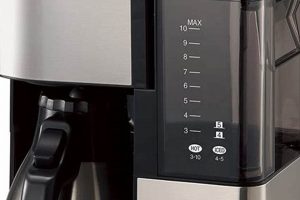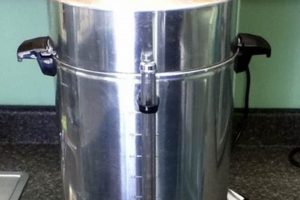This pour-over coffee brewing device, specifically designed to yield approximately 30 ounces of brewed coffee, comprises a single piece of borosilicate glass shaped into an hourglass. Its design incorporates a wooden collar and leather tie, serving as both an insulator and handle. The device uses uniquely folded paper filters, thicker than those used in other pour-over methods, resulting in a clean, sediment-free cup of coffee.
The popularity of this brewing method stems from its ability to produce coffee with exceptional clarity and flavor. The thick paper filters trap oils and sediments that can cloud the taste of the final brew. Its aesthetic appeal and ease of use have further contributed to its enduring presence in both home and professional coffee-making environments. The device’s simple design, relatively unchanged since its invention, reflects a commitment to functional elegance and high-quality coffee extraction.
Subsequent sections will detail the specific brewing process using this apparatus, considerations for grind size and water temperature, cleaning and maintenance procedures, and comparisons to alternative brewing methods. Further discussion will involve the factors influencing optimal extraction and potential troubleshooting for common brewing challenges.
Tips for Optimal Use
Achieving a consistently high-quality brew with the specified pour-over device requires attention to detail and a systematic approach. The following guidelines outline key considerations for maximizing flavor extraction and minimizing common errors.
Tip 1: Employ a consistent grind size. A medium-coarse grind, resembling coarse sea salt, is recommended to ensure even extraction and prevent over-extraction, which leads to bitterness.
Tip 2: Pre-wet the filter thoroughly. This step eliminates paper taste and preheats the brewing device, contributing to a more stable brewing temperature.
Tip 3: Observe the bloom. After saturating the grounds, allow approximately 30 seconds for the coffee to bloom, releasing trapped carbon dioxide and enhancing flavor development.
Tip 4: Maintain a slow and steady pour. A consistent, circular pouring motion promotes even saturation of the grounds and prevents channeling, which can result in uneven extraction.
Tip 5: Monitor water temperature. Water heated to between 195-205F (90-96C) is optimal for extracting desirable flavor compounds without scorching the coffee.
Tip 6: Clean the device thoroughly after each use. Residual coffee oils can accumulate and negatively impact the flavor of subsequent brews. Use a mild detergent and warm water, ensuring all surfaces are clean.
Tip 7: Store unused filters properly. Protect the filters from absorbing ambient odors, which can transfer to the coffee during brewing. Keep them in a sealed container or their original packaging.
Adhering to these recommendations will contribute to a more nuanced and satisfying coffee experience. Consistent application of these techniques facilitates reproducible results and a higher quality final product.
The subsequent section will address the cleaning and maintenance specifics necessary to prolong the life of the equipment and maintain optimal brewing performance.
1. Glass construction
The glass construction is a fundamental element of the “chemex coffee maker 6 cup,” directly influencing the purity of the brewed coffee. Borosilicate glass, a heat-resistant and non-porous material, is utilized in the device’s manufacture. This choice of material prevents the absorption of flavors or odors from previous brews, ensuring that each batch of coffee maintains its intended profile. In contrast to plastic or metal alternatives, borosilicate glass is inert, meaning it does not react chemically with the coffee during the brewing process. For example, some metal brewers can impart a metallic taste to the coffee, whereas plastic can leach chemicals when exposed to high temperatures. This effect is completely avoided with the use of the Chemex’s glass construction.
The glass construction also permits visual monitoring of the brewing process. The user can observe the saturation of the coffee grounds, the rate of water flow, and the overall progress of the extraction. This visual feedback loop allows for adjustments to the brewing technique, leading to a more controlled and refined final product. Furthermore, the single-piece design of the Chemex, formed from glass, minimizes potential points of weakness or contamination that would be present in multi-part designs. The smooth, non-reactive surface is also easier to clean, preventing the buildup of oils and residues that can affect the flavor of subsequent brews.
In summary, the glass construction of the “chemex coffee maker 6 cup” is not merely an aesthetic choice, but a functional imperative. The material’s inert nature, heat resistance, and visual transparency directly contribute to the clarity, purity, and control afforded by the brewing method. While alternative materials could potentially reduce manufacturing costs, they would invariably compromise the quality and characteristics that define the Chemex brewing experience. The glass construction directly is the essence of the Chemex appeal to serious coffee consumers.
2. Paper Filter Thickness
The paper filter thickness is an integral factor influencing the final coffee profile produced by the “chemex coffee maker 6 cup.” Unlike standard pour-over filters, the Chemex employs a uniquely thick paper, contributing significantly to the brewing process and the resulting cup’s characteristics.
- Sediment and Oil Removal
The exceptional thickness of the Chemex filter effectively removes almost all sediment and oils from the coffee. This results in a remarkably clean and clear cup, free from the turbidity often found in other brewing methods. The absence of these oils also contributes to a lighter body and a perceived brightness in the coffee’s acidity. Compared to a French press, which allows significant sediment and oils to pass through, the Chemex delivers a noticeably different textural and flavor experience.
- Flow Rate Regulation
The density of the filter regulates the flow rate of water through the coffee grounds. The slower flow rate, dictated by the filter thickness, extends the contact time between the water and the coffee, promoting a more thorough extraction of soluble compounds. While this longer extraction time can be beneficial, it also necessitates careful attention to grind size and water temperature to prevent over-extraction and the development of bitter flavors.
- Flavor Modulation
The filter’s ability to remove oils and micro-fines alters the perceived flavor profile of the coffee. The removal of oils reduces the mouthfeel and mutes some of the bolder, more robust flavor notes, emphasizing subtler and more delicate aromatics. This results in a coffee that is often described as having a cleaner, brighter, and more nuanced flavor compared to methods that allow more oils to pass through. A side-by-side comparison with a metal filter brew will highlight the differences produced in terms of mouthfeel, body, and overall flavor clarity.
- Material Composition
The specific paper used in Chemex filters is designed for its strength and purity. Chemex filters are typically made from high-quality, bleached or unbleached paper designed not to impart any unwanted flavors. In some cases, the paper may be pre-folded for convenient use. The filters are made from specially bonded paper, ensuring that the paper’s fibers will not be released into the brew as it is filtered. This bonding is very important in avoiding muddy flavors and textural issues that can be introduced by lower quality filter papers.
In conclusion, the paper filter thickness of the “chemex coffee maker 6 cup” is not merely a physical attribute but a critical determinant of the brewing process and the final cup quality. Its influence on sediment removal, flow rate, and flavor modulation distinguishes the Chemex from other brewing methods, contributing to its reputation for producing clean, bright, and nuanced coffee. This emphasis on filtration results in a product that delivers a very specific flavor profile that will appeal to many coffee aficionados.
3. Pour-over technique
The pour-over technique is intrinsically linked to the functionality and performance of the “chemex coffee maker 6 cup.” This brewing method dictates the manner in which hot water is introduced to the coffee grounds, directly impacting extraction efficiency and the resulting beverage’s characteristics. The Chemex’s design, particularly its thick paper filter and conical shape, necessitates a controlled and deliberate pour-over technique to achieve optimal results. For instance, a fast or uneven pour can lead to channeling, where water bypasses some of the coffee grounds, resulting in under-extraction and a weak, sour taste. Conversely, an overly slow pour can lead to over-extraction and a bitter flavor profile. A proper pour-over technique with a Chemex is not merely about pouring water; it’s about carefully managing the water’s interaction with the coffee to elicit the desired flavors.
Specific elements of the pour-over technique, such as the initial “bloom” pour, the subsequent controlled pouring pattern, and the total brewing time, are crucial considerations when using a Chemex. The bloom pour, a small amount of water used to saturate the grounds and release trapped gases, prepares the coffee bed for more uniform extraction. The subsequent pour should be performed in a circular or spiral motion to ensure all grounds are evenly saturated, promoting a consistent extraction. The total brewing time, typically around 4 minutes, must be carefully monitored to prevent over- or under-extraction. Any deviation from these guidelines can have tangible effects on the coffee’s taste, body, and aroma. A practical application of this understanding involves adjusting the grind size and water temperature based on the observed brewing time and the resulting coffee’s flavor. A finer grind or hotter water might be used if the coffee tastes weak, while a coarser grind or cooler water may be necessary if the coffee is bitter.
In summary, the pour-over technique is not a supplemental skill when using a “chemex coffee maker 6 cup,” but rather an integrated component that dictates the final quality of the brew. Challenges such as inconsistent grind size, fluctuating water temperature, or an improper pouring technique can significantly detract from the Chemex’s potential. Mastering the pour-over technique, therefore, is essential for unlocking the full capabilities of the “chemex coffee maker 6 cup” and consistently producing a balanced, flavorful cup of coffee. The connection between technique and the Chemex design emphasizes a broader theme in coffee brewing: the importance of precision and control in achieving consistent, high-quality results.
4. Brew capacity (30oz)
The brew capacity of 30 ounces (approximately 890 ml) is a defining characteristic of the “chemex coffee maker 6 cup,” significantly influencing its intended use and target consumer. This volume dictates the number of servings that can be produced in a single brewing session, directly impacting its suitability for individual consumption versus small-group sharing. The specific capacity aligns the device towards users who regularly consume multiple cups of coffee or who wish to brew a batch large enough to serve two to three individuals. A smaller capacity would limit its usefulness for those desiring multiple servings, while a larger capacity would increase the physical footprint of the device and potentially make it less practical for single-person use. Therefore, the “chemex coffee maker 6 cup” strikes a balance between serving capacity and overall convenience, optimized for a specific segment of coffee drinkers.
The 30-ounce capacity has implications for the ratio of coffee grounds to water employed during brewing. This ratio, a critical determinant of the coffee’s strength and flavor, must be adjusted appropriately to account for the overall volume being produced. For example, using a standard coffee-to-water ratio, a brewer must carefully measure the coffee grounds to ensure they are proportionally scaled to the 30-ounce water volume. Imprecise measurement can lead to under-extracted, weak coffee, or over-extracted, bitter coffee. Furthermore, the heat retention properties of the glass carafe become more relevant with a larger brew capacity. A full 30-ounce batch will cool down more slowly than a smaller batch, allowing for a more prolonged enjoyment of the coffee at a consistent temperature. This characteristic is advantageous for users who prefer to savor their coffee over an extended period, or for those serving multiple individuals, where a reserve of warm coffee is desirable.
In summary, the 30-ounce brew capacity of the “chemex coffee maker 6 cup” is not an arbitrary figure but a carefully considered design element that aligns the device with specific usage scenarios. It accommodates multiple servings while maintaining a manageable size, and it influences the optimal coffee-to-water ratio and heat retention characteristics of the brewer. Overlooking the significance of this capacity can lead to suboptimal brewing practices and a less satisfying coffee experience. Therefore, understanding and appreciating the 30-ounce capacity is crucial for fully leveraging the capabilities of the “chemex coffee maker 6 cup” and achieving consistent, high-quality brewing results.
5. Aesthetic Design
The aesthetic design of the “chemex coffee maker 6 cup” is not merely a superficial attribute but an integral component that contributes significantly to its enduring appeal and functionality. The form factor directly influences user experience and reinforces the perception of quality, underscoring its relevance in the context of coffee brewing.
- Hourglass Shape
The iconic hourglass shape is a defining visual element. It is formed from a single piece of borosilicate glass and its seamless construction emphasizes simplicity and purity. The curved form is also functional, acting as a natural guide for the brewing process, allowing the user to observe the coffee extraction. Its presence is more than decorative; it is a deliberate choice that integrates form and function.
- Wooden Collar and Leather Tie
The wooden collar and leather tie serve as both insulators and aesthetic counterpoints to the glass body. The wooden collar provides a comfortable grip while the leather tie, traditionally rawhide, adds a tactile element and visual contrast, creating a sense of crafted quality. These materials introduce a human element into the design, contrasting the clinical precision of the glass. This design is a nod to traditional craftsmanship and a contrast of textures.
- Visual Clarity and Transparency
The clear borosilicate glass offers complete visual transparency of the brewing process. This allows the user to monitor the coffee grounds, water saturation, and extraction, which enhances the experience and provides feedback on brewing technique. The transparency is not only a functional benefit but also a visual one. The coffee becomes a visual element of the brewing process, turning a simple action into an aesthetic experience.
- Minimalist Approach
The overall design embraces a minimalist approach, devoid of superfluous ornamentation. The focus remains on the essential components, emphasizing functionality and purity of form. This minimalist aesthetic aligns with a contemporary design sensibility and reinforces the perception of quality. This is the type of design that focuses on what it is, and avoids unnessecary elements.
These facets of the “chemex coffee maker 6 cup’s” aesthetic design, from its shape to the carefully chosen materials, combine to create a visually appealing and functionally effective brewing device. The seamless integration of form and function contributes to its enduring popularity and reinforces its reputation as a design classic. The aesthetic qualities of this device are deeply connected with its utilitarian function.
Frequently Asked Questions
This section addresses common inquiries regarding the use, maintenance, and expected performance of the 6-cup Chemex coffee maker. The aim is to provide clear, concise answers to ensure optimal brewing experiences.
Question 1: What is the optimal grind size for the 6-cup Chemex?
A medium-coarse grind, similar to coarse sea salt, is recommended. This grind size facilitates even extraction and prevents over-extraction, which can result in bitterness. Finer grinds may clog the filter, while coarser grinds may lead to under-extraction and a weak, sour flavor.
Question 2: What water temperature is ideal for brewing with the Chemex?
Water temperature should be between 195-205F (90-96C). This range allows for efficient extraction of desirable flavor compounds without scalding the coffee grounds. Using a thermometer to verify water temperature is recommended for consistent results.
Question 3: How should the Chemex filter be prepared before brewing?
The filter should be pre-wet with hot water before adding coffee grounds. This step removes any paper taste and preheats the brewing device, contributing to a more stable brewing temperature. Ensure the pre-wetting water is discarded before proceeding.
Question 4: How long should the brewing process take?
The total brewing time should ideally be between 3.5 and 4.5 minutes. This duration allows for sufficient extraction without over-extraction. Adjustments to grind size and water temperature may be necessary to achieve the desired brewing time.
Question 5: How often should the Chemex be cleaned?
The Chemex should be cleaned thoroughly after each use to remove residual coffee oils and prevent the buildup of stale flavors. A mild detergent and warm water are typically sufficient. Periodic cleaning with a specialized coffee equipment cleaner may also be beneficial.
Question 6: Can the Chemex be used on a stovetop?
The Chemex is constructed from borosilicate glass, which is heat-resistant but not designed for direct stovetop use. Using the Chemex on a stovetop can lead to cracking or breakage. Employ a separate kettle for heating water.
Adhering to these guidelines will enhance the brewing experience and ensure the consistent production of high-quality coffee. Careful attention to each step in the process is essential for maximizing the Chemex’s potential.
The following section will explore alternative brewing methods and compare their characteristics to those of the Chemex.
Conclusion
This exploration has detailed the multifaceted nature of the “chemex coffee maker 6 cup,” examining its defining characteristics such as its borosilicate glass construction, the role of its uniquely thick paper filters, the importance of the pour-over technique, its specific brew capacity, and its minimalist aesthetic design. Each of these elements contributes to the apparatus’s ability to produce coffee with exceptional clarity and nuance, distinguishing it from alternative brewing methods.
The continued relevance of the “chemex coffee maker 6 cup” in the modern coffee landscape underscores the enduring value of precision and intentionality in brewing practices. Prospective users are encouraged to consider these factors to fully appreciate and effectively utilize this classic device, ensuring a consistently rewarding coffee experience. Its significance lies not only in its brewing capabilities but also in its representation of considered design and thoughtful coffee preparation.







![The Best Turquoise Coffee Maker: [Brand Name] & More! Safem Fabrication - Precision Engineering & Custom Manufacturing Solutions The Best Turquoise Coffee Maker: [Brand Name] & More! | Safem Fabrication - Precision Engineering & Custom Manufacturing Solutions](https://deacoffee.com/wp-content/uploads/2025/06/th-1651-300x200.jpg)